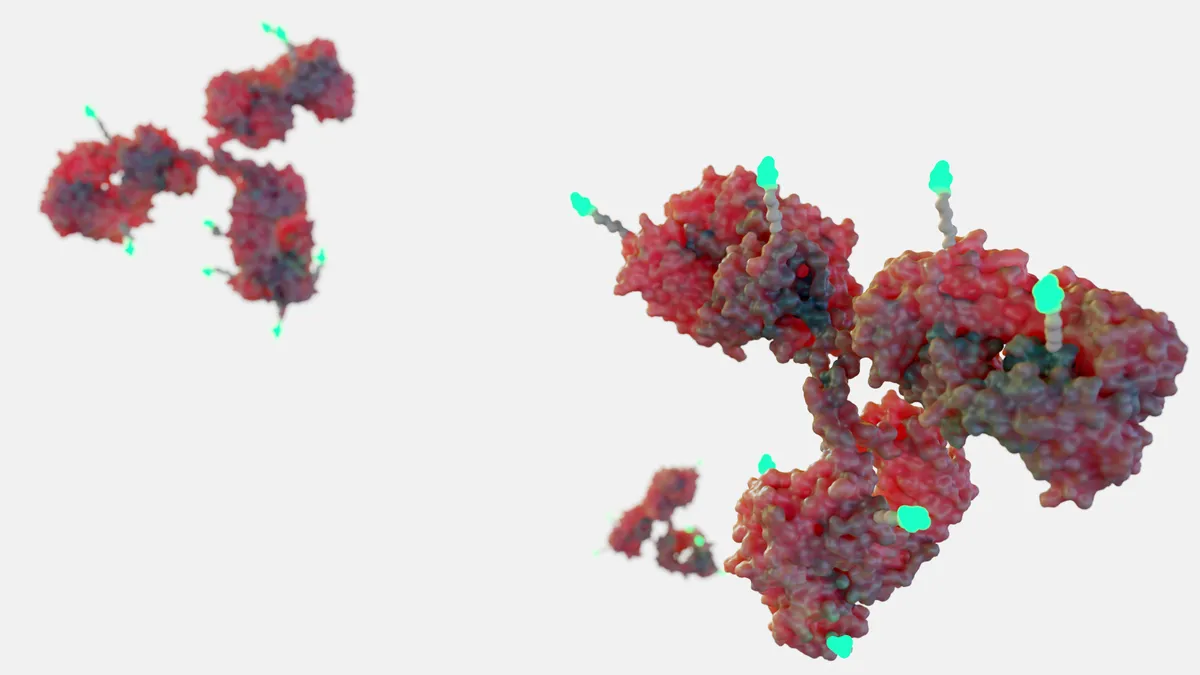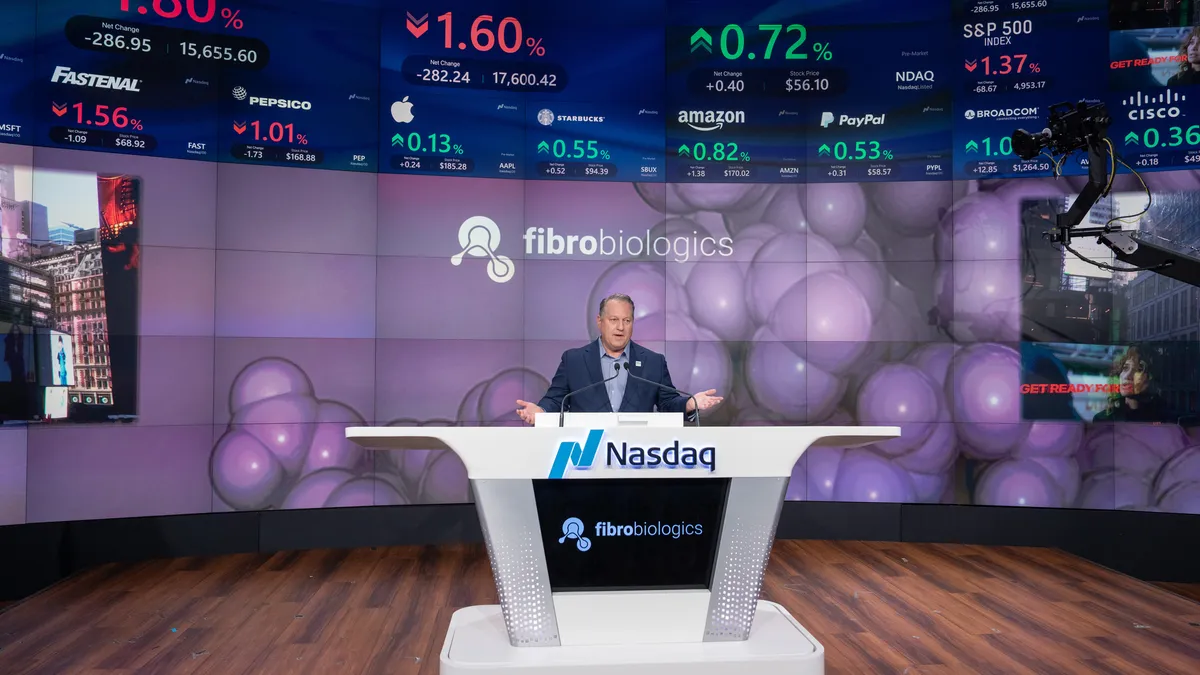Welcome to today’s Biotech Spotlight, a series featuring companies that are creating breakthrough technologies and products. Today, we’re looking at aTyr Pharma, which is using its tRNA platform to develop new therapies for rare diseases associated with fibrosis, inflammation and cancer.
In focus with: Dr. Sanjay Shukla, CEO and president, aTyr Pharma
aTyr Pharma’s vision: With an intellectual property portfolio covering 300 protein compositions from all 20 tRNA synthetase genes, aTyr Pharma is engaged in the discovery and development of “first-in-class medicines based on pathways affected by extracellular tRNA synthetases.”
“Our founders discovered that a protein derived from one tRNA synthetase gene could act as an extracellular modulator of angiogenesis when new blood vessels are formed,” Shukla said. “Recent research developments have further reinforced the idea that tRNA synthetases may more broadly play important roles in cellular responses to certain disease states, in particular, cellular stress and tissue homeostasis.”
aTyr’s approach is to identify these pathways to create new modulating biologic therapies. The company’s lead product efzofitimod is a “first-in-class biologic based on a naturally occurring, lung-enriched splice variant of histidyl-tRNA synthetase (HARS) that downregulates immune responses via selective modulation of neuropilin-2 (NRP2).” The company is developing the compound to target interstitial lung disease (ILD), a group of rare lung conditions that causes scarring or fibrosis of lung tissues.

“We are currently investigating efzofitimod in patients with pulmonary sarcoidosis, the most prevalent form of ILD, in a global phase 3 study known as EFZO-FIT,” Shukla said. Right now, we’re the world’s leading company in tRNA biology and we have the most developed interstitial lung disease asset. We are on the cusp of having a therapy in an area that has never been approved. I’m looking forward to the day when we have multiple therapies approved for different rare diseases because I think that’s where a novel biology platform can really be applied.”
At a glance: While working as a biostatistician for a Big Pharma company in the mid-90s, Shukla became interested in the clinical and drug sides of the business. During this time, he spent several years working on temozolomide, which is, to this day, the only approved therapy for glioblastoma.
“This experience stuck with me — to look at research and attack the diseases and conditions that were the toughest or where we needed better therapies,” he said. “When I returned to industry after my medical training, I looked to those areas where there’s unmet need. I spent the better part of the 2000s working in lupus nephritis, myasthenia gravis, pemphigus vulgaris — all conditions (where we) felt patients needed something better. And I gained a lot of experience (advancing therapies) in rare disease. Not everything worked but I’m proud that we created data that allowed drugs in the future to work. So now we see approved therapies in lupus nephritis (and) in myasthenia gravis.”
Coming to aTyr seven years ago from Novartis provided Shukla with the opportunity to address more conditions that have few, if any, options.
“I’ve been lucky to lead this organization and direct the platform toward a condition that I always thought — going back to medical school — was a disease that needed better therapies and was perhaps ignored by industry — and that’s sarcoidosis,” he said.
Why it matters: If approved, efzofitimod will be available to treat the 200,000 people in the U.S. living with pulmonary sarcoidosis, a rare disease caused by lung inflammation, which is most commonly found in the Black community and women.
“The work that our team is conducting at aTyr represents the importance of inclusion and diversity in drug development,” Shukla said. “They are just a sliver of the approximate 37 million people in the U.S. living with lung diseases, but their conditions are equally important, and until now, have been sidelined due to monies dedicated to developing therapies for diseases affecting more people.”
“Hopefully we will be presenting a package to worldwide regulators that can lead to the approval of the first approved sarcoidosis drug ever.”

Dr. Sanjay Shukla
CEO, president, aTyr Pharma
In late 2021, aTyr received positive data for a trial including 37 sarcoidosis patients.
“For the first time ever, a therapy showed the ability to improve lung function, improve quality of life, while removing steroids,” Shukla said. “Leading experts said (efzofitimod) checked three boxes that no therapy had ever done before.”
The company is enrolling patients for a phase 3 trial with a data readout expected in early 2025.
“Hopefully we will be presenting a package to worldwide regulators that can lead to the approval of the first approved sarcoidosis drug ever,” Shukla said.
This week, aTyr announced a phase 2 study of efzofitimod for patients with systemic sclerosis-associated interstitial lung disease (SSc-ILD), the leading cause of death in patients with scleroderma.
Here, Shukla discusses the company’s synthetase platform, its history and the clinical trajectory for efzofitimod.
This interview has been edited for brevity and style.
PHARMAVOICE: What makes aTyr Pharma’s synthetase platform different?
DR. SANJAY SHUKLA: The platform was one of the main reasons I joined aTyr. I was at Novartis working for a much larger company but I was really intrigued about aTyr in the early days because the scientific founder, Paul Schimmel, is a pioneer in biopharma. He’s launched several very successful companies — all on the cutting edge of science. He co-founded Alnylam, which kicked off a whole era of RNA medicine. aTyr is specifically built around the insights that he developed 12 to 15 years ago around what these synthetases do. Essentially, they are enzymes that help us make proteins. When I was in medical school, this is all I really understood about them. They were kind of construction workers that conjugated a reaction between a specific amino acid and the tRNA, and this then enables us to make proteins within the cell.
What Schimmel discovered and published over a decade ago was that these synthetases play a different role, a non-enzymatic role when they leave the cell. This was a startling discovery because it was really not known until this time that these fragments could do anything else. There were viewed to be inert. These enzymes break apart into little fragments and variants. Then they migrate out into different organ systems, where they play a very different role. We’ve now learned they seem to modulate the immune system. So, imagine their day job, if you will, is as a construction worker and then at night, they’re doing something very different. This is a new immunobiology and immunology. And, we are on the cutting edge of harnessing these potent protein therapeutics and directing them to diseases where they could be useful.
We’ve mapped out several of areas that seem to be able to control fibrosis and inflammation, one of which we have taken all the way into phase 3.
“I’ve been lucky to lead this organization and direct the platform toward a condition that I always thought — going back to medical school — was a disease that needed better therapies and was perhaps ignored by industry — and that’s sarcoidosis."

Dr. Sanjay Shukla
CEO, president, aTyr Pharma
Alnylam is now a $20 billion company. It created a whole new class of therapies. We envision ourselves getting to that level. I can’t promise when that will be, but I do think that having that first approved tRNA derived therapy is going to allow us to continue to be at the forefront. My expectation is after the efzofitimod is successful, we will be able to generate more therapies from our IP estate.
There are several tRNA companies popping up and creating excitement around this area of science. Is this one of those times where a rising tide lifting many boats is good for everybody?
Absolutely correct. aTyr has been in the forefront of tRNA biology for quite some time, specifically we are working with fragments of enzymes that are involved in tRNA biology. Companies are moving into the space now because of the success aTyr has had in validating some of this biology, being able to harness it and create a proof of concept in diseases. So now there are more companies getting involved looking at other fragments, other parts of the biology. We’re fortunate because we control a large IP portfolio around these proteinaceous fragments.
We’re proud that there’s probably at least a half a dozen other companies with slightly different approaches looking at how tRNA biology can be harnessed to create new medicines. We just have a good 10 to 12-year head start.
Your lead compound efzofitimod is in phase 3. What’s next?
We are conducting a phase 3 trial with efzofitimod in pulmonary sarcoidosis patients in about 10 countries around the world. We’re looking to recruit more than 260 patients. This will be the largest sarcoidosis trial ever. And we are prioritizing an endpoint that we believe is most important to patients and providers — steroid reduction. That’s a unique element. In fact, we are now seeing follow-on companies getting into sarcoidosis, which is great. And because we have shown this steroid reduction signal in our last trial, patients are now demanding this in future trials. So, there has been a bit of a paradigm shift because of the way that we’ve approached our drug development.
We are also looking at the expansion of efzofitimod into an adjacent interstitial lung disease. We announced that scleroderma-related ILD could be an area where we could help patients. This is another rare disease that attacks the lungs, and mortality rates are high — half these patients are at risk of dying because it’s the worse sub-type of scleroderma. Again, there’s a huge unmet need here.
Are you prepared to take this drug to market yourselves?
We always have to prepare for all contingencies. We have the ability. I have worked, and many of the team here has, at much larger organizations that had commercial footprints. So we are prepared to market the drug ourselves. Of course, that will involve us getting a lot bigger. As you can image, biotech companies also have to always think about partnering. So, we actively engage in discussions around the potential for that. But my goal is whether aTyr is doing this or we’re doing this with a partner, that the drug will be marketed.































































